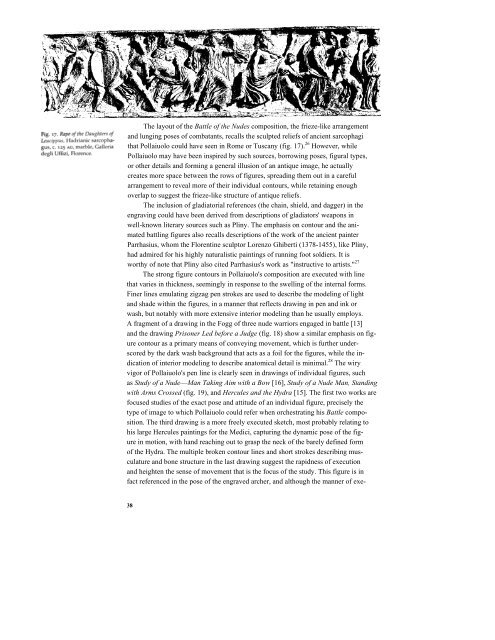Battle of the Nudes
Battle of the Nudes
Battle of the Nudes
You also want an ePaper? Increase the reach of your titles
YUMPU automatically turns print PDFs into web optimized ePapers that Google loves.
The layout <strong>of</strong> <strong>the</strong> <strong>Battle</strong> <strong>of</strong> <strong>the</strong> <strong>Nudes</strong> composition, <strong>the</strong> frieze-like arrangement<br />
and lunging poses <strong>of</strong> combatants, recalls <strong>the</strong> sculpted reliefs <strong>of</strong> ancient sarcophagi<br />
that Pollaiuolo could have seen in Rome or Tuscany (fig. 17). 26 However, while<br />
Pollaiuolo may have been inspired by such sources, borrowing poses, figural types,<br />
or o<strong>the</strong>r details and forming a general illusion <strong>of</strong> an antique image, he actually<br />
creates more space between <strong>the</strong> rows <strong>of</strong> figures, spreading <strong>the</strong>m out in a careful<br />
arrangement to reveal more <strong>of</strong> <strong>the</strong>ir individual contours, while retaining enough<br />
overlap to suggest <strong>the</strong> frieze-like structure <strong>of</strong> antique reliefs.<br />
The inclusion <strong>of</strong> gladiatorial references (<strong>the</strong> chain, shield, and dagger) in <strong>the</strong><br />
engraving could have been derived from descriptions <strong>of</strong> gladiators' weapons in<br />
well-known literary sources such as Pliny. The emphasis on contour and <strong>the</strong> ani-<br />
mated battling figures also recalls descriptions <strong>of</strong> <strong>the</strong> work <strong>of</strong> <strong>the</strong> ancient painter<br />
Parrhasius, whom <strong>the</strong> Florentine sculptor Lorenzo Ghiberti (1378-1455), like Pliny,<br />
had admired for his highly naturalistic paintings <strong>of</strong> running foot soldiers. It is<br />
worthy <strong>of</strong> note that Pliny also cited Parrhasius's work as "instructive to artists." 27<br />
The strong figure contours in Pollaiuolo's composition are executed with line<br />
that varies in thickness, seemingly in response to <strong>the</strong> swelling <strong>of</strong> <strong>the</strong> internal forms.<br />
Finer lines emulating zigzag pen strokes are used to describe <strong>the</strong> modeling <strong>of</strong> light<br />
and shade within <strong>the</strong> figures, in a manner that reflects drawing in pen and ink or<br />
wash, but notably with more extensive interior modeling than he usually employs.<br />
A fragment <strong>of</strong> a drawing in <strong>the</strong> Fogg <strong>of</strong> three nude warriors engaged in battle [13]<br />
and <strong>the</strong> drawing Prisoner Led before a Judge (fig. 18) show a similar emphasis on fig-<br />
ure contour as a primary means <strong>of</strong> conveying movement, which is fur<strong>the</strong>r under-<br />
scored by <strong>the</strong> dark wash background that acts as a foil for <strong>the</strong> figures, while <strong>the</strong> in-<br />
dication <strong>of</strong> interior modeling to describe anatomical detail is minimal. 28 The wiry<br />
vigor <strong>of</strong> Pollaiuolo's pen line is clearly seen in drawings <strong>of</strong> individual figures, such<br />
as Study <strong>of</strong> a Nude—Man Taking Aim with a Bow [16], Study <strong>of</strong> a Nude Man, Standing<br />
with Arms Crossed (fig. 19), and Hercules and <strong>the</strong> Hydra [15]. The first two works are<br />
focused studies <strong>of</strong> <strong>the</strong> exact pose and attitude <strong>of</strong> an individual figure, precisely <strong>the</strong><br />
type <strong>of</strong> image to which Pollaiuolo could refer when orchestrating his <strong>Battle</strong> compo-<br />
sition. The third drawing is a more freely executed sketch, most probably relating to<br />
his large Hercules paintings for <strong>the</strong> Medici, capturing <strong>the</strong> dynamic pose <strong>of</strong> <strong>the</strong> fig-<br />
ure in motion, with hand reaching out to grasp <strong>the</strong> neck <strong>of</strong> <strong>the</strong> barely defined form<br />
<strong>of</strong> <strong>the</strong> Hydra. The multiple broken contour lines and short strokes describing mus-<br />
culature and bone structure in <strong>the</strong> last drawing suggest <strong>the</strong> rapidness <strong>of</strong> execution<br />
and heighten <strong>the</strong> sense <strong>of</strong> movement that is <strong>the</strong> focus <strong>of</strong> <strong>the</strong> study. This figure is in<br />
fact referenced in <strong>the</strong> pose <strong>of</strong> <strong>the</strong> engraved archer, and although <strong>the</strong> manner <strong>of</strong> exe-<br />
38
















